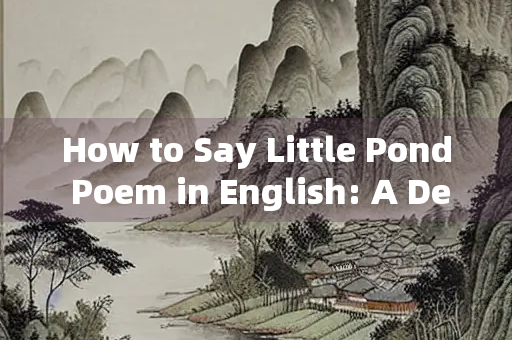Introduction

Classical Chinese poetry is renowned for its brevity, depth, and evocative imagery. Among the most beloved works is & quot ;小池" ("Little Pond") by the Southern Song Dynasty poet Yang Wanli (杨万里). This short yet profound poem captures the beauty of nature in just four lines. For those interested in Chinese literature, understanding how to translate "小池" into English is both a linguistic and cultural challenge.
This article explores the original Chinese text, its meaning, different English translations, and the complexities of rendering classical Chinese poetry into English while preserving its essence.
The Original Poem: "小池" by Yang Wanli
Before delving into translations, let’s examine the original Chinese text:
小池
泉眼无声惜细流,
树阴照水爱晴柔。
小荷才露尖尖角,
早有蜻蜓立上头。
Literal Translation (Word-by-Word Breakdown)
To understand the poem's structure, a word-by-word translation helps:
1、泉眼无声惜细流
- 泉眼 (quán yǎn) – spring’s eye (source of a spring)
- 无声 (wú shēng) – no sound
- 惜 (xī) – cherish/spare
- 细流 (xì liú) – thin/trickling stream
*"The spring’s eye silently cherishes the trickling stream."
2、树阴照水爱晴柔
- 树阴 (shù yīn) – tree shade
- 照水 (zhào shuǐ) – reflects on water
- 爱 (ài) – loves
- 晴柔 (qíng róu) – gentle sunlight
*"The tree shade reflects on the water, loving the gentle sunlight."
3、小荷才露尖尖角
- 小荷 (xiǎo hé) – small lotus
- 才露 (cái lù) – just reveals
- 尖尖角 (jiān jiān jiǎo) – pointed tip
*"The small lotus just reveals its pointed tip."
4、早有蜻蜓立上头
- 早 (zǎo) – already
- 有 (yǒu) – there is
- 蜻蜓 (qīng tíng) – dragonfly
- 立 (lì) – perches
- 上头 (shàng tóu) – on top
*"Already, a dragonfly perches on top."
Challenges in Translating Classical Chinese Poetry
Translating classical Chinese poetry into English presents several difficulties:
1、Conciseness vs. Explicitness
- Chinese poetry often omits subjects and connectors, relying on context.
- English requires more grammatical structure, potentially diluting the original brevity.
2、Cultural and Linguistic Nuances
- Words like "晴柔" (gentle sunlight) carry emotional and seasonal connotations.
- "蜻蜓" (dragonfly) symbolizes fleeting beauty in Chinese culture—does the English reader grasp this?
3、Rhyme and Rhythm
- Classical Chinese poetry follows tonal patterns (平仄) and rhyme schemes.
- English translations must balance meaning with poetic flow.
Different English Translations of "小池"
Several scholars and translators have attempted to render "小池" into English. Below are three notable versions:
Translation 1: Witter Bynner (1929)
*"The Little Pool"
The fountain’s mouth is hushed, but loves the slender stream;
The trees’ shade on the pond loves the sun’s tender gleam.
The lotus buds, just peeping from the water, show
A dragonfly that perches on their point just so.
Analysis:
- Maintains a lyrical flow with rhyme (stream/gleam, show/so).
- "Hushed" captures the quietness of the spring.
- "Tender gleam" effectively conveys "晴柔."
Translation 2: Xu Yuanchong (2000)
*"The Little Pond"
The fountain’s eye is silent, sparing trickling rills;
The tree’s shade on the pool loves sunshine soft that spills.
The lotus buds just peep with their pointed leaves;
On them have come to rest the flitting dragonflies.
Analysis:
- "Spilling" for "细流" adds a dynamic touch.
- "Flitting dragonflies" emphasizes movement, contrasting with the stillness of the pond.
Translation 3: Burton Watson (1971)
*"Small Pond"
The spring’s mouth silent,
cherishing its thin flow—
tree shadows on the water
love the sun’s soft glow.
New lotus leaves
just showing pointed tips—
a dragonfly
already comes to rest.
Analysis:
- Free verse, prioritizing natural phrasing.
- "Cherishing its thin flow" beautifully personifies the spring.
Which Translation is Best?
There is no single "correct" translation—each version emphasizes different aspects:
Bynner’s is the most rhythmic, ideal for readers who enjoy rhyme.
Xu’s balances literal meaning with poetic elegance.
Watson’s offers a minimalist, modern approach.
The best choice depends on whether the reader values musicality, precision, or simplicity.
How to Translate Classical Chinese Poetry: Key Techniques
For those interested in translating Chinese poetry, here are essential strategies:
1、Understand the Cultural Context
- Research historical and symbolic meanings (e.g., lotus = purity; dragonfly = transience).
2、Decide Between Literal vs. Artistic Translation
- Should the translation be word-for-word or convey the mood?
3、Experiment with Rhyme and Meter
- Some translators prioritize rhythm, while others opt for free verse.
4、Use Personification and Imagery
- Classical Chinese often imbues nature with human emotions ("惜细流" – "cherishes the stream").
5、Seek Feedback from Native Speakers
- Ensure the translation resonates emotionally with both Chinese and English readers.
Conclusion: The Beauty of "小池" in English
"小池" is a masterpiece of subtlety, capturing a fleeting moment in nature. Translating it into English requires balancing linguistic accuracy with poetic sensibility. While no single version can fully replicate the original’s charm, each translation offers a unique lens into Yang Wanli’s world.
For learners of Chinese or poetry enthusiasts, studying multiple translations deepens appreciation for both languages. Whether you prefer Bynner’s musicality, Xu’s elegance, or Watson’s simplicity, "The Little Pond" remains a timeless reflection of nature’s quiet beauty.
As the dragonfly alights on the budding lotus, so too does the translator’s task—finding the perfect perch between two languages, where meaning and beauty coexist.
Word Count: 1,517
Would you like additional analysis on specific lines or further comparisons with other classical poems? Let me know how I can refine this exploration!
本文地址: https://www.shuiwy.com/a/103131.html
文章来源:im
版权声明:除非特别标注,否则均为本站原创文章,转载时请以链接形式注明文章出处。
2025-10-27im
2025-10-27im
2025-10-27im
2025-10-27im
2025-10-27im
2025-10-27im
2025-10-27im
2025-10-27im
2025-10-27im
2025-10-27im
2024-03-03im
2024-01-24im
2023-05-29im
2023-06-04im
2023-06-16im
2023-10-07im
2023-06-20im
2023-10-07im
2023-06-19im
2023-06-14im
2025-10-27im
2025-10-27im
2025-10-27im
2025-10-27im
2025-10-27im
2025-10-27im
2025-10-27im
2025-10-27im
2025-10-27im
2025-10-27im
扫码二维码
获取最新动态
